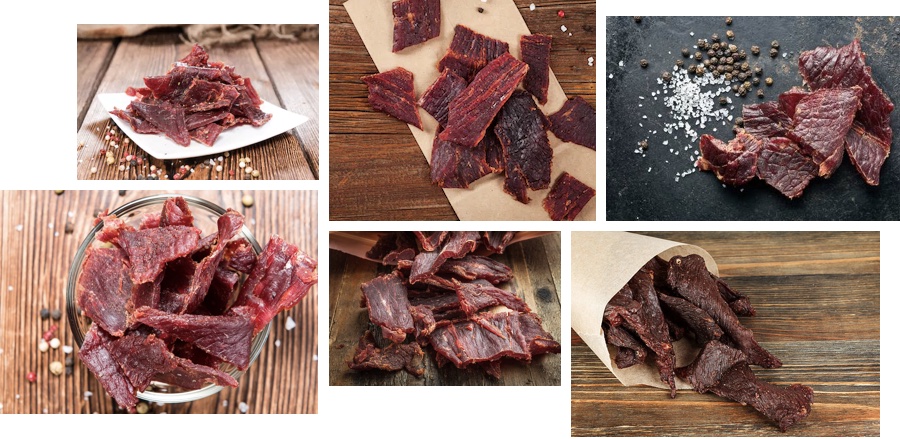Dried Meat Types
Dried, cured meat has existed for hundreds of years. Over time different types of meat, including beef, chicken, fish and game have been adapted into a number of different dried meat forms. Beef jerky, which is smoked, seasoned and cut into strips is much different from biltong, which is cured, air dried and can come in strips, shredded or even in powdered form. But there are a number of other dried meat forms as well.
Jerky
Jerky is lean trimmed meat that has been cut into strips and dried (dehydrated) to prevent spoilage. Normally, this drying includes the addition of salt to prevent bacteria growth before the meat has finished the dehydrating process. The word "jerky" derives from the Quechua word ch'arki which means "dried, salted meat". All that is needed to produce basic "jerky" is a low-temperature drying method, and salt to inhibit bacterial growth.
Modern manufactured jerky is often marinated, prepared with a seasoned spice rub or liquid, or smoked with low heat (usually under 70 °C/160 °F). Store-bought jerky commonly includes sweeteners such as brown sugar.
Jerky is ready-to-eat, needs no additional preparation and can be stored for months without refrigeration. To ensure maximum shelf-life a proper protein-to-moisture content is required in the final cured product.
Many products which are sold as jerky consist of highly processed, chopped and formed meat rather than traditional sliced whole-muscle meat. These products may contain more fat, but moisture content, as in the whole-muscle product, must meet a 0.75 to 1 moisture-to protein ratio in the US. Chemical preservatives can prevent oxidative spoilage, but the moisture-to-protein ratio prevents microbial spoilage by low water activity. Some jerky products are very high in sugar and therefore taste very sweet – unlike biltong, which rarely contains added sugars.

Biltong
Biltong is a form of dried, cured meat that originated in Southern African countries (South Africa, Zimbabwe, Namibia, Botswana and Zambia). Various types of meat are used to produce it, ranging from beef and game meats to fillets of meat cut into strips following the grain of the muscle, or flat pieces sliced across the grain. It is related to beef jerky in that they are both spiced, dried meats; however, the typical ingredients, taste and production processes may differ.
The word biltong is from the Dutch bil ("buttock”") and tong ("strip" or "tongue").

Droëwors
Droëwors is a Southern African snack food, based on the traditional, coriander-seed spiced boerewors sausage. It is usually made from dunwors (Afrikaans for "thin sausage") rather than dikwors ("thick sausage"), as the thinner sausage dries more quickly and is thus less likely to spoil before it can be preserved. If dikwors is to be used, it is usually flattened to provide a larger surface area for drying.
The recipe used for these dried sausages is similar to that for boerewors, though pork and veal are usually replaced by beef, as the former can go rancid when dried, mutton fat replaces the pork fat used in boerewors. Drying makes the sausage ideal for unrefrigerated storage.
Droëwors is unusual among dried meats in being dried quickly in warm, dry conditions, unlike traditional droge worst Italian cured salumi, which are dried slowly in relatively cold and humid conditions. A further difference is that droëwors does not contain curing agent as found in a traditional cured sausage. A direct result of this is that droëwors should not be kept in moist conditions as mold can begin to form more easily than would happen with a cured sausage.
This product is related both in name and in nature to the Dutch droge worst a.k.a. metworst.
